Accounting for Business: Financial Statement Analysis and Proposals
VerifiedAdded on 2023/06/18
|12
|1842
|108
Report
AI Summary
This report provides a comprehensive financial analysis of a business, including an income statement and statement of financial position to assess profitability and financial health. It calculates payback period and net present value (NPV) for investment appraisal, advising on financial viability and considering non-financial factors. The report also includes a break-even analysis for various proposals, using marginal costing to determine the most financially viable option. Desklib offers this and many more solved assignments for students.

Accounting for Business
Paraphrase This Document
Need a fresh take? Get an instant paraphrase of this document with our AI Paraphraser
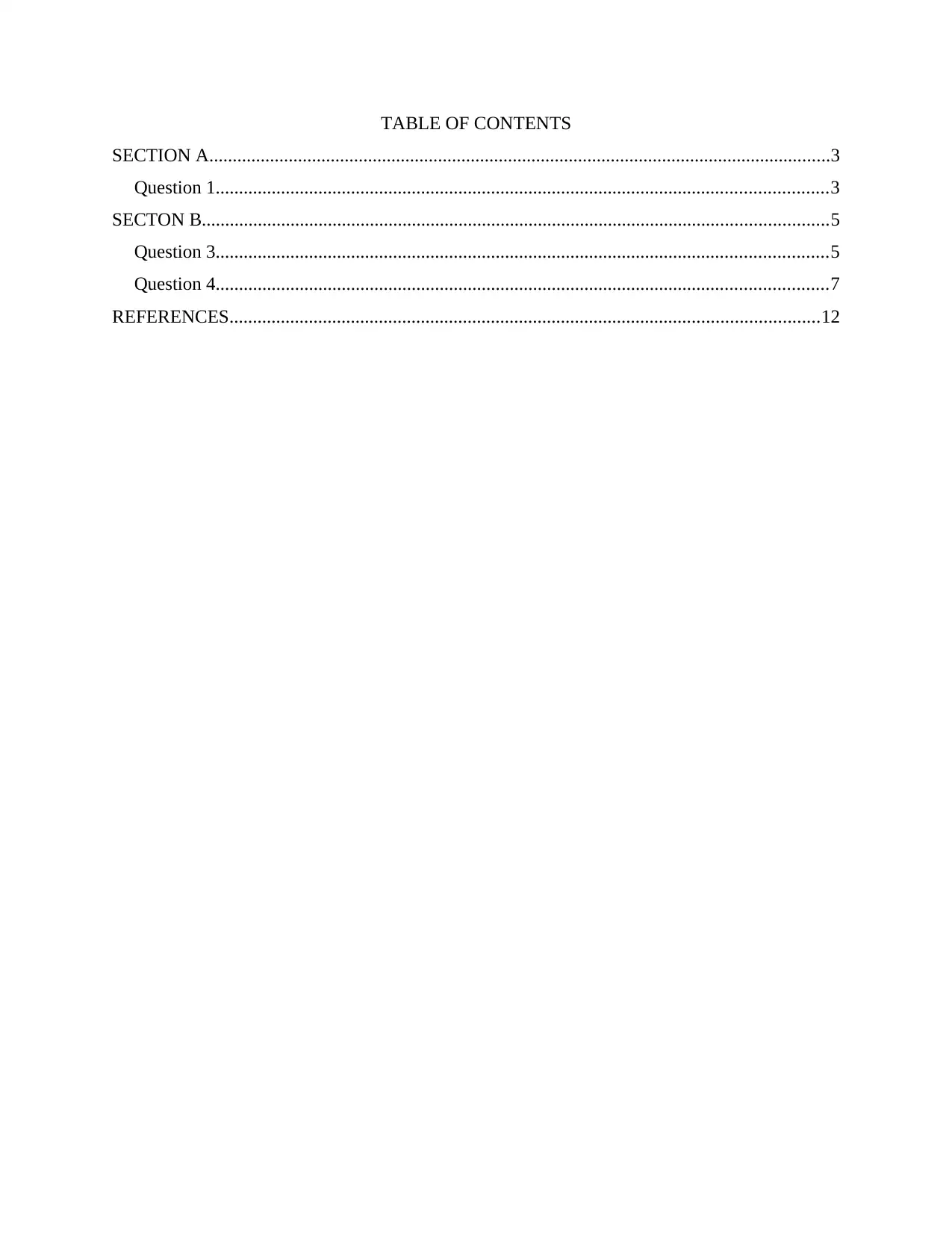
TABLE OF CONTENTS
SECTION A.....................................................................................................................................3
Question 1...................................................................................................................................3
SECTON B......................................................................................................................................5
Question 3...................................................................................................................................5
Question 4...................................................................................................................................7
REFERENCES..............................................................................................................................12
SECTION A.....................................................................................................................................3
Question 1...................................................................................................................................3
SECTON B......................................................................................................................................5
Question 3...................................................................................................................................5
Question 4...................................................................................................................................7
REFERENCES..............................................................................................................................12
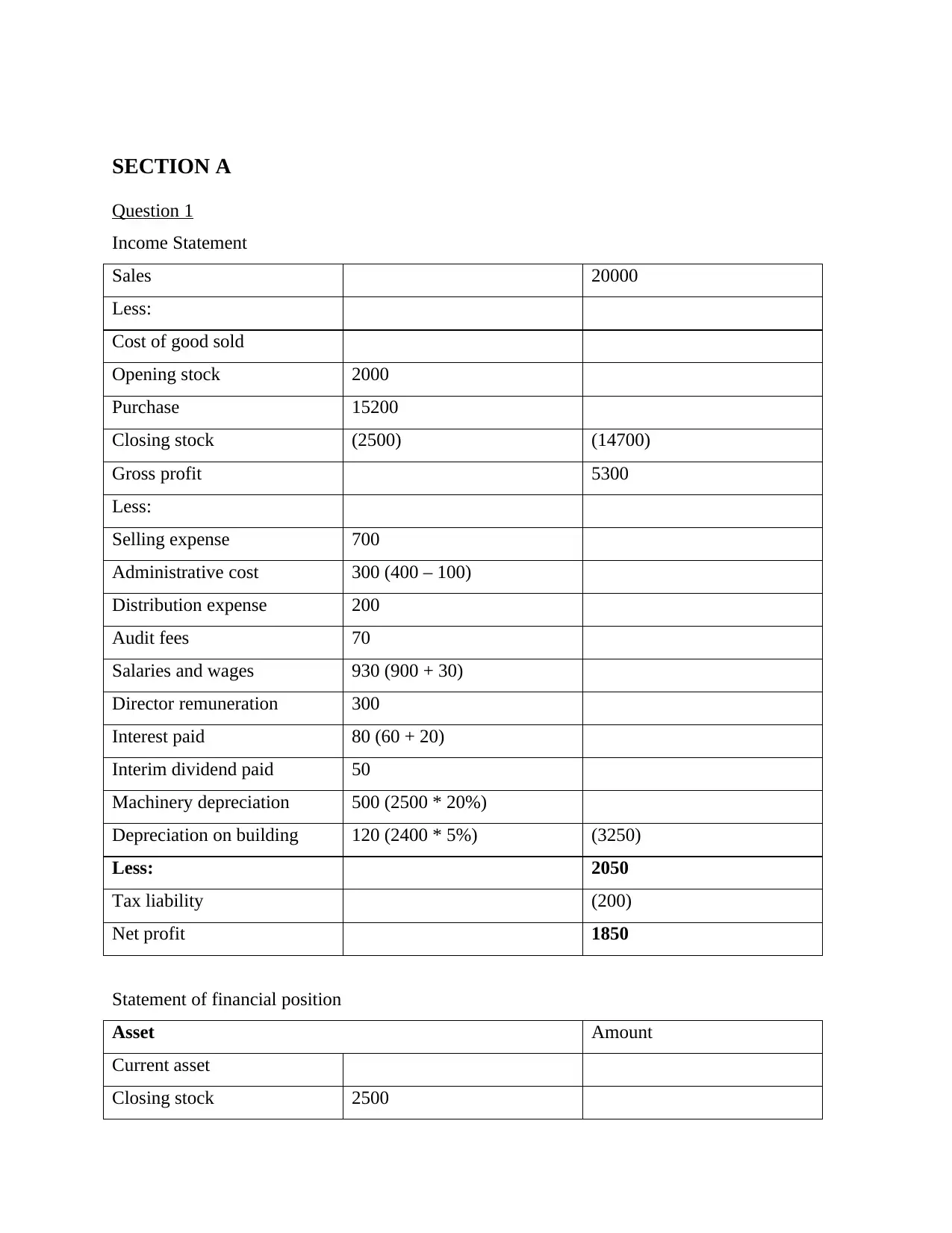
SECTION A
Question 1
Income Statement
Sales 20000
Less:
Cost of good sold
Opening stock 2000
Purchase 15200
Closing stock (2500) (14700)
Gross profit 5300
Less:
Selling expense 700
Administrative cost 300 (400 – 100)
Distribution expense 200
Audit fees 70
Salaries and wages 930 (900 + 30)
Director remuneration 300
Interest paid 80 (60 + 20)
Interim dividend paid 50
Machinery depreciation 500 (2500 * 20%)
Depreciation on building 120 (2400 * 5%) (3250)
Less: 2050
Tax liability (200)
Net profit 1850
Statement of financial position
Asset Amount
Current asset
Closing stock 2500
Question 1
Income Statement
Sales 20000
Less:
Cost of good sold
Opening stock 2000
Purchase 15200
Closing stock (2500) (14700)
Gross profit 5300
Less:
Selling expense 700
Administrative cost 300 (400 – 100)
Distribution expense 200
Audit fees 70
Salaries and wages 930 (900 + 30)
Director remuneration 300
Interest paid 80 (60 + 20)
Interim dividend paid 50
Machinery depreciation 500 (2500 * 20%)
Depreciation on building 120 (2400 * 5%) (3250)
Less: 2050
Tax liability (200)
Net profit 1850
Statement of financial position
Asset Amount
Current asset
Closing stock 2500
⊘ This is a preview!⊘
Do you want full access?
Subscribe today to unlock all pages.

Trusted by 1+ million students worldwide
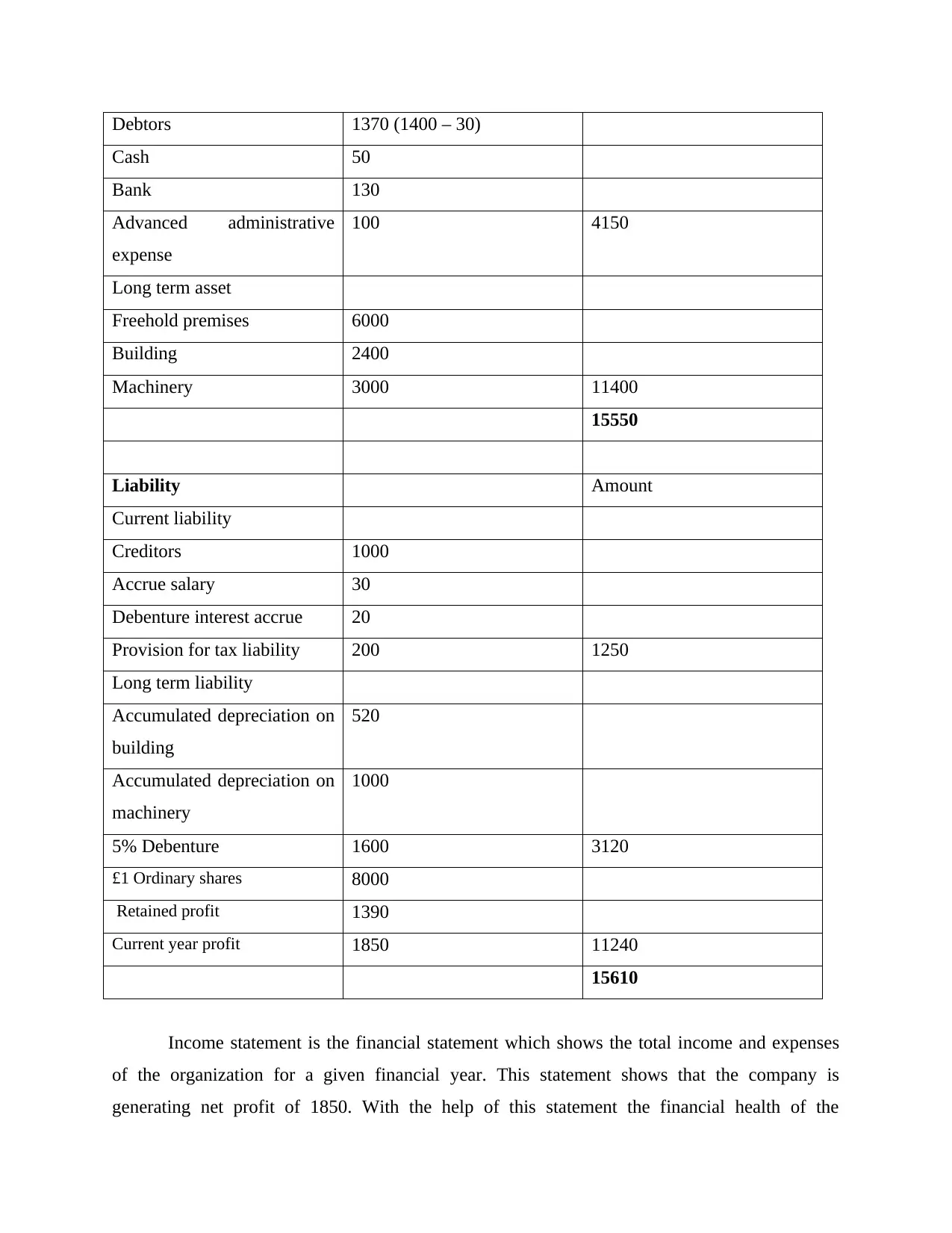
Debtors 1370 (1400 – 30)
Cash 50
Bank 130
Advanced administrative
expense
100 4150
Long term asset
Freehold premises 6000
Building 2400
Machinery 3000 11400
15550
Liability Amount
Current liability
Creditors 1000
Accrue salary 30
Debenture interest accrue 20
Provision for tax liability 200 1250
Long term liability
Accumulated depreciation on
building
520
Accumulated depreciation on
machinery
1000
5% Debenture 1600 3120
£1 Ordinary shares 8000
Retained profit 1390
Current year profit 1850 11240
15610
Income statement is the financial statement which shows the total income and expenses
of the organization for a given financial year. This statement shows that the company is
generating net profit of 1850. With the help of this statement the financial health of the
Cash 50
Bank 130
Advanced administrative
expense
100 4150
Long term asset
Freehold premises 6000
Building 2400
Machinery 3000 11400
15550
Liability Amount
Current liability
Creditors 1000
Accrue salary 30
Debenture interest accrue 20
Provision for tax liability 200 1250
Long term liability
Accumulated depreciation on
building
520
Accumulated depreciation on
machinery
1000
5% Debenture 1600 3120
£1 Ordinary shares 8000
Retained profit 1390
Current year profit 1850 11240
15610
Income statement is the financial statement which shows the total income and expenses
of the organization for a given financial year. This statement shows that the company is
generating net profit of 1850. With the help of this statement the financial health of the
Paraphrase This Document
Need a fresh take? Get an instant paraphrase of this document with our AI Paraphraser
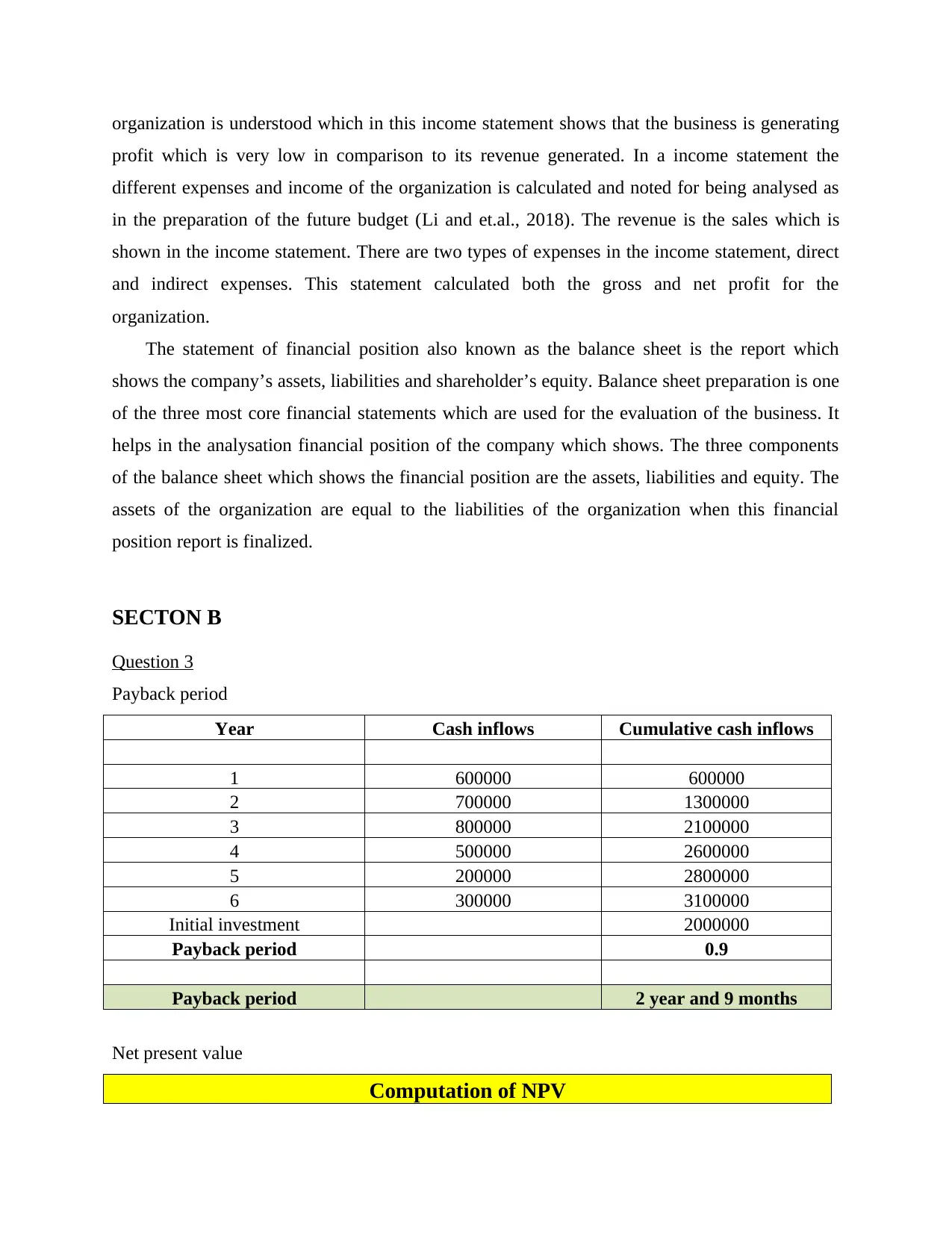
organization is understood which in this income statement shows that the business is generating
profit which is very low in comparison to its revenue generated. In a income statement the
different expenses and income of the organization is calculated and noted for being analysed as
in the preparation of the future budget (Li and et.al., 2018). The revenue is the sales which is
shown in the income statement. There are two types of expenses in the income statement, direct
and indirect expenses. This statement calculated both the gross and net profit for the
organization.
The statement of financial position also known as the balance sheet is the report which
shows the company’s assets, liabilities and shareholder’s equity. Balance sheet preparation is one
of the three most core financial statements which are used for the evaluation of the business. It
helps in the analysation financial position of the company which shows. The three components
of the balance sheet which shows the financial position are the assets, liabilities and equity. The
assets of the organization are equal to the liabilities of the organization when this financial
position report is finalized.
SECTON B
Question 3
Payback period
Year Cash inflows Cumulative cash inflows
1 600000 600000
2 700000 1300000
3 800000 2100000
4 500000 2600000
5 200000 2800000
6 300000 3100000
Initial investment 2000000
Payback period 0.9
Payback period 2 year and 9 months
Net present value
Computation of NPV
profit which is very low in comparison to its revenue generated. In a income statement the
different expenses and income of the organization is calculated and noted for being analysed as
in the preparation of the future budget (Li and et.al., 2018). The revenue is the sales which is
shown in the income statement. There are two types of expenses in the income statement, direct
and indirect expenses. This statement calculated both the gross and net profit for the
organization.
The statement of financial position also known as the balance sheet is the report which
shows the company’s assets, liabilities and shareholder’s equity. Balance sheet preparation is one
of the three most core financial statements which are used for the evaluation of the business. It
helps in the analysation financial position of the company which shows. The three components
of the balance sheet which shows the financial position are the assets, liabilities and equity. The
assets of the organization are equal to the liabilities of the organization when this financial
position report is finalized.
SECTON B
Question 3
Payback period
Year Cash inflows Cumulative cash inflows
1 600000 600000
2 700000 1300000
3 800000 2100000
4 500000 2600000
5 200000 2800000
6 300000 3100000
Initial investment 2000000
Payback period 0.9
Payback period 2 year and 9 months
Net present value
Computation of NPV
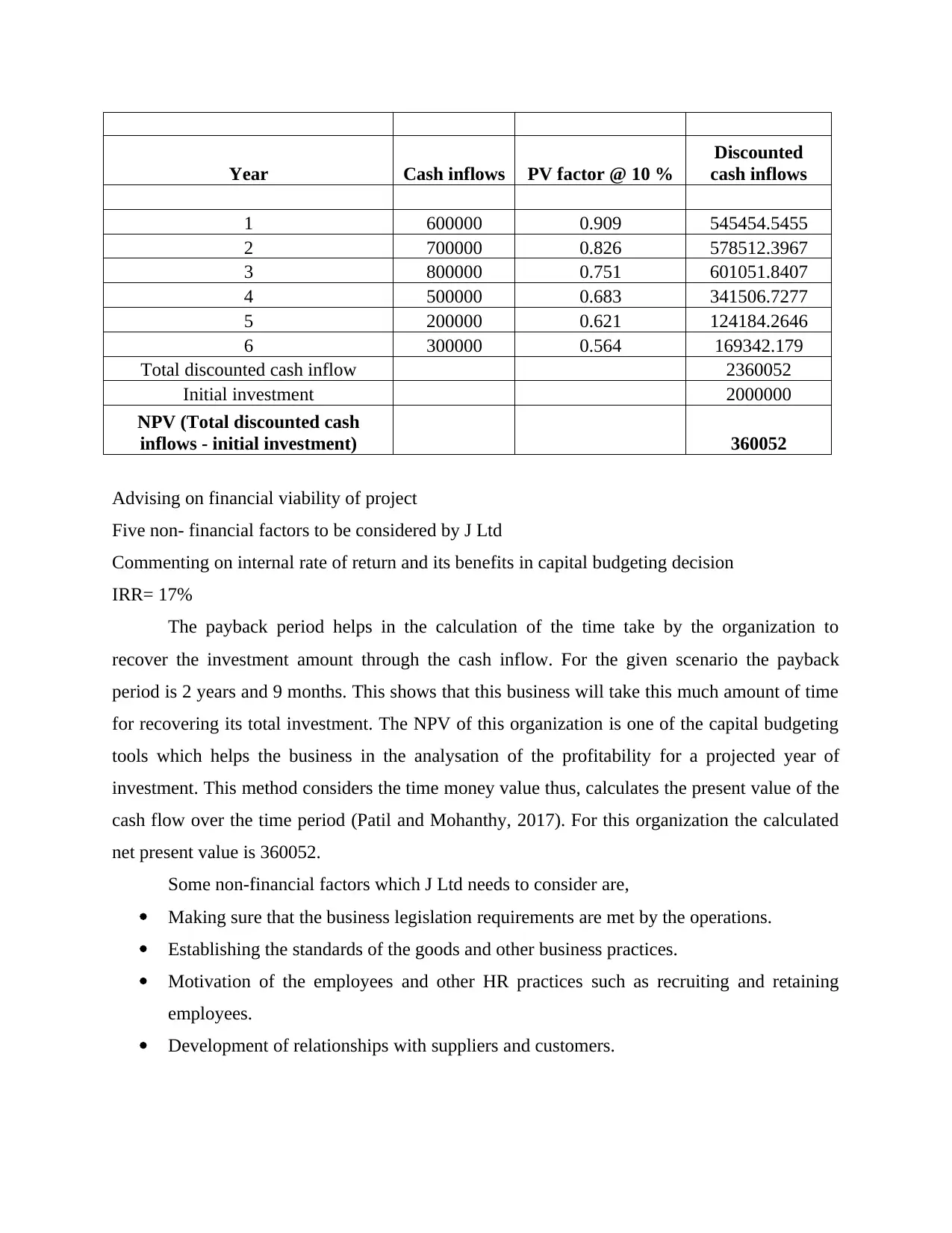
Year Cash inflows PV factor @ 10 %
Discounted
cash inflows
1 600000 0.909 545454.5455
2 700000 0.826 578512.3967
3 800000 0.751 601051.8407
4 500000 0.683 341506.7277
5 200000 0.621 124184.2646
6 300000 0.564 169342.179
Total discounted cash inflow 2360052
Initial investment 2000000
NPV (Total discounted cash
inflows - initial investment) 360052
Advising on financial viability of project
Five non- financial factors to be considered by J Ltd
Commenting on internal rate of return and its benefits in capital budgeting decision
IRR= 17%
The payback period helps in the calculation of the time take by the organization to
recover the investment amount through the cash inflow. For the given scenario the payback
period is 2 years and 9 months. This shows that this business will take this much amount of time
for recovering its total investment. The NPV of this organization is one of the capital budgeting
tools which helps the business in the analysation of the profitability for a projected year of
investment. This method considers the time money value thus, calculates the present value of the
cash flow over the time period (Patil and Mohanthy, 2017). For this organization the calculated
net present value is 360052.
Some non-financial factors which J Ltd needs to consider are,
Making sure that the business legislation requirements are met by the operations.
Establishing the standards of the goods and other business practices.
Motivation of the employees and other HR practices such as recruiting and retaining
employees.
Development of relationships with suppliers and customers.
Discounted
cash inflows
1 600000 0.909 545454.5455
2 700000 0.826 578512.3967
3 800000 0.751 601051.8407
4 500000 0.683 341506.7277
5 200000 0.621 124184.2646
6 300000 0.564 169342.179
Total discounted cash inflow 2360052
Initial investment 2000000
NPV (Total discounted cash
inflows - initial investment) 360052
Advising on financial viability of project
Five non- financial factors to be considered by J Ltd
Commenting on internal rate of return and its benefits in capital budgeting decision
IRR= 17%
The payback period helps in the calculation of the time take by the organization to
recover the investment amount through the cash inflow. For the given scenario the payback
period is 2 years and 9 months. This shows that this business will take this much amount of time
for recovering its total investment. The NPV of this organization is one of the capital budgeting
tools which helps the business in the analysation of the profitability for a projected year of
investment. This method considers the time money value thus, calculates the present value of the
cash flow over the time period (Patil and Mohanthy, 2017). For this organization the calculated
net present value is 360052.
Some non-financial factors which J Ltd needs to consider are,
Making sure that the business legislation requirements are met by the operations.
Establishing the standards of the goods and other business practices.
Motivation of the employees and other HR practices such as recruiting and retaining
employees.
Development of relationships with suppliers and customers.
⊘ This is a preview!⊘
Do you want full access?
Subscribe today to unlock all pages.

Trusted by 1+ million students worldwide
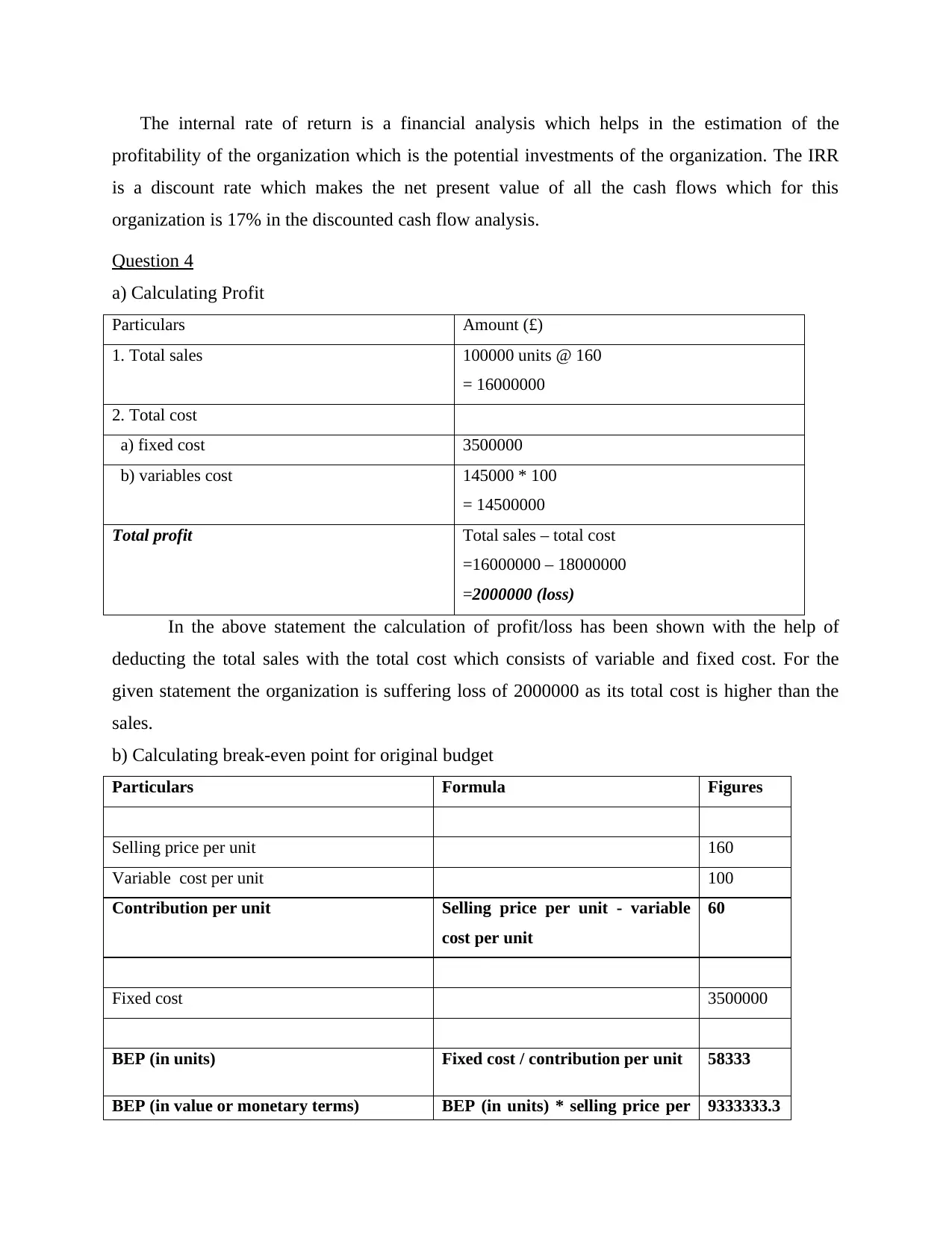
The internal rate of return is a financial analysis which helps in the estimation of the
profitability of the organization which is the potential investments of the organization. The IRR
is a discount rate which makes the net present value of all the cash flows which for this
organization is 17% in the discounted cash flow analysis.
Question 4
a) Calculating Profit
Particulars Amount (£)
1. Total sales 100000 units @ 160
= 16000000
2. Total cost
a) fixed cost 3500000
b) variables cost 145000 * 100
= 14500000
Total profit Total sales – total cost
=16000000 – 18000000
=2000000 (loss)
In the above statement the calculation of profit/loss has been shown with the help of
deducting the total sales with the total cost which consists of variable and fixed cost. For the
given statement the organization is suffering loss of 2000000 as its total cost is higher than the
sales.
b) Calculating break-even point for original budget
Particulars Formula Figures
Selling price per unit 160
Variable cost per unit 100
Contribution per unit Selling price per unit - variable
cost per unit
60
Fixed cost 3500000
BEP (in units) Fixed cost / contribution per unit 58333
BEP (in value or monetary terms) BEP (in units) * selling price per 9333333.3
profitability of the organization which is the potential investments of the organization. The IRR
is a discount rate which makes the net present value of all the cash flows which for this
organization is 17% in the discounted cash flow analysis.
Question 4
a) Calculating Profit
Particulars Amount (£)
1. Total sales 100000 units @ 160
= 16000000
2. Total cost
a) fixed cost 3500000
b) variables cost 145000 * 100
= 14500000
Total profit Total sales – total cost
=16000000 – 18000000
=2000000 (loss)
In the above statement the calculation of profit/loss has been shown with the help of
deducting the total sales with the total cost which consists of variable and fixed cost. For the
given statement the organization is suffering loss of 2000000 as its total cost is higher than the
sales.
b) Calculating break-even point for original budget
Particulars Formula Figures
Selling price per unit 160
Variable cost per unit 100
Contribution per unit Selling price per unit - variable
cost per unit
60
Fixed cost 3500000
BEP (in units) Fixed cost / contribution per unit 58333
BEP (in value or monetary terms) BEP (in units) * selling price per 9333333.3
Paraphrase This Document
Need a fresh take? Get an instant paraphrase of this document with our AI Paraphraser

unit
Break-even point is the situation in which the company suffers no profit or loss, at this
number of units the total revenue of the business is equal to the total costs (Lessambo, 2018). In
the given statement the break-even point is calculated at 9333333.3, where as the unit of break
even point is 58333.
c) Calculating break-even for Proposal 1
Selling price = 160 + (160*10%) = £176
Variable cost = £104
Sales = 130000 units
Particulars Amount (£)
1. Total sales 130000 units @ 176
= 22880000
2. Total cost
a) fixed cost 3500000
b) variables cost 145000 * 103
= 14935000
Total profit Total sales – total cost
=22880000 – 18435000
=4445000
Break-even analysis
Particulars Formula Figures
Selling price per unit 176
Variable cost per unit 103
Contribution per unit
Selling price per unit - variable
cost per unit 73
Fixed cost 3500000
BEP (in units) Fixed cost / contribution per unit 47945
Break-even point is the situation in which the company suffers no profit or loss, at this
number of units the total revenue of the business is equal to the total costs (Lessambo, 2018). In
the given statement the break-even point is calculated at 9333333.3, where as the unit of break
even point is 58333.
c) Calculating break-even for Proposal 1
Selling price = 160 + (160*10%) = £176
Variable cost = £104
Sales = 130000 units
Particulars Amount (£)
1. Total sales 130000 units @ 176
= 22880000
2. Total cost
a) fixed cost 3500000
b) variables cost 145000 * 103
= 14935000
Total profit Total sales – total cost
=22880000 – 18435000
=4445000
Break-even analysis
Particulars Formula Figures
Selling price per unit 176
Variable cost per unit 103
Contribution per unit
Selling price per unit - variable
cost per unit 73
Fixed cost 3500000
BEP (in units) Fixed cost / contribution per unit 47945
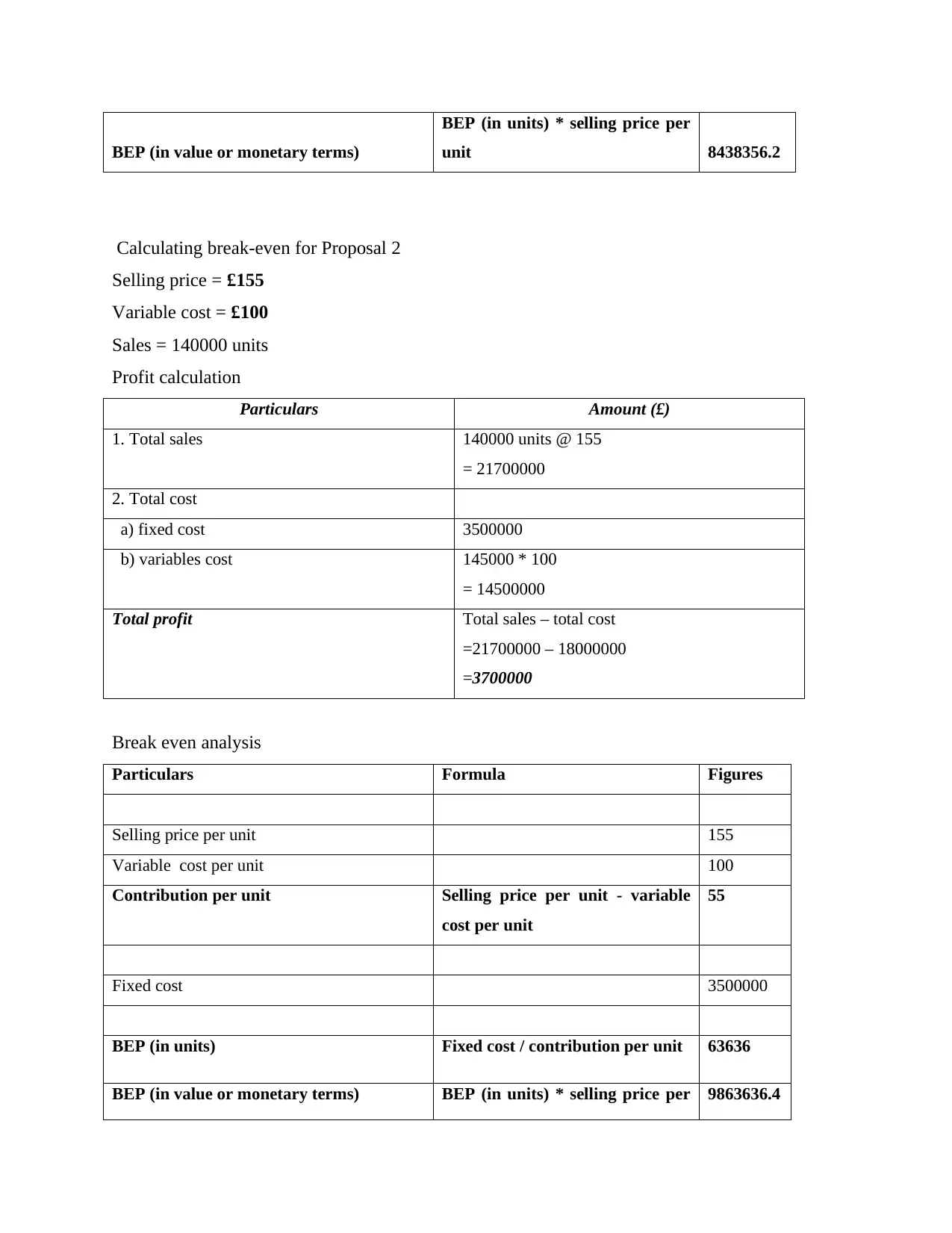
BEP (in value or monetary terms)
BEP (in units) * selling price per
unit 8438356.2
Calculating break-even for Proposal 2
Selling price = £155
Variable cost = £100
Sales = 140000 units
Profit calculation
Particulars Amount (£)
1. Total sales 140000 units @ 155
= 21700000
2. Total cost
a) fixed cost 3500000
b) variables cost 145000 * 100
= 14500000
Total profit Total sales – total cost
=21700000 – 18000000
=3700000
Break even analysis
Particulars Formula Figures
Selling price per unit 155
Variable cost per unit 100
Contribution per unit Selling price per unit - variable
cost per unit
55
Fixed cost 3500000
BEP (in units) Fixed cost / contribution per unit 63636
BEP (in value or monetary terms) BEP (in units) * selling price per 9863636.4
BEP (in units) * selling price per
unit 8438356.2
Calculating break-even for Proposal 2
Selling price = £155
Variable cost = £100
Sales = 140000 units
Profit calculation
Particulars Amount (£)
1. Total sales 140000 units @ 155
= 21700000
2. Total cost
a) fixed cost 3500000
b) variables cost 145000 * 100
= 14500000
Total profit Total sales – total cost
=21700000 – 18000000
=3700000
Break even analysis
Particulars Formula Figures
Selling price per unit 155
Variable cost per unit 100
Contribution per unit Selling price per unit - variable
cost per unit
55
Fixed cost 3500000
BEP (in units) Fixed cost / contribution per unit 63636
BEP (in value or monetary terms) BEP (in units) * selling price per 9863636.4
⊘ This is a preview!⊘
Do you want full access?
Subscribe today to unlock all pages.

Trusted by 1+ million students worldwide
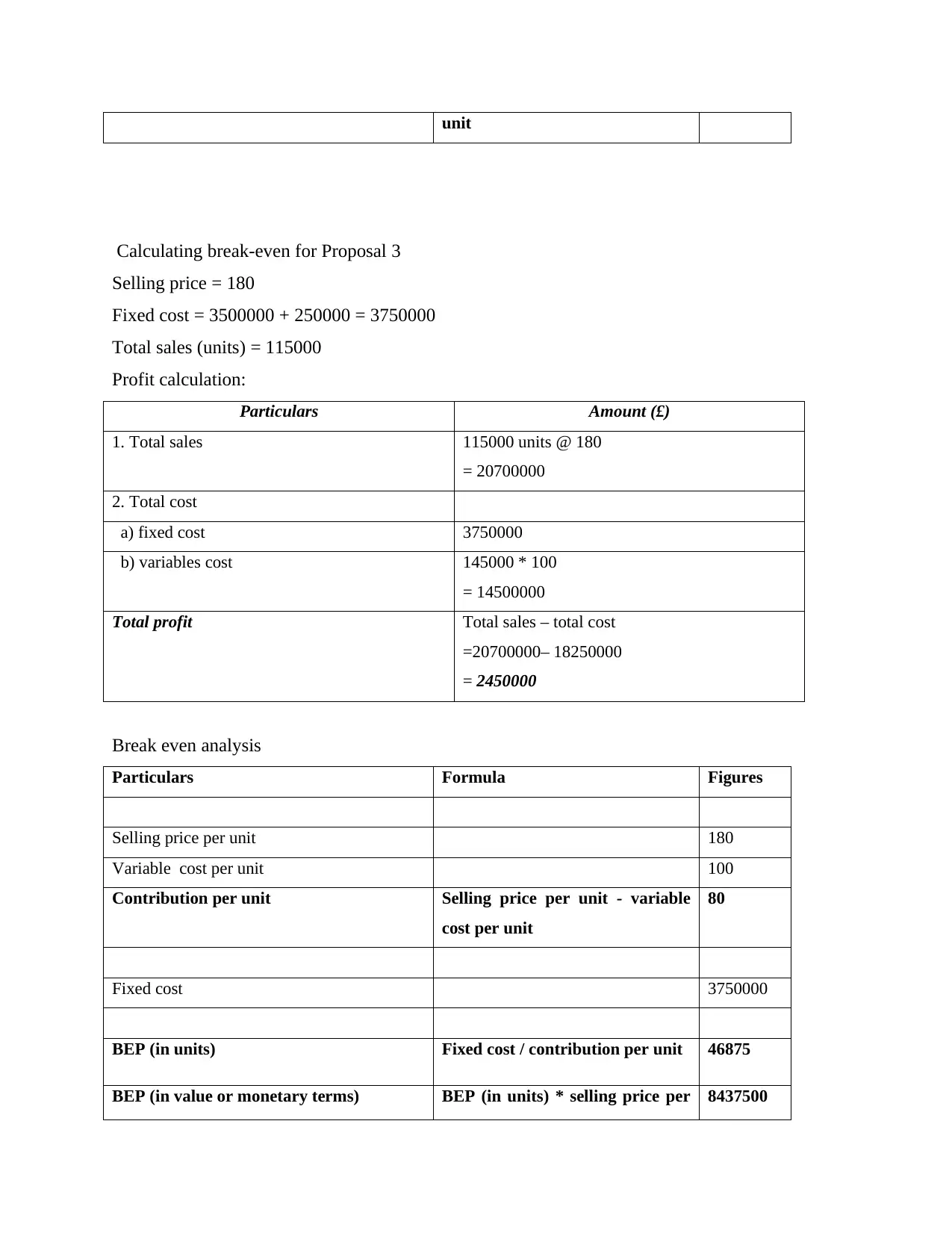
unit
Calculating break-even for Proposal 3
Selling price = 180
Fixed cost = 3500000 + 250000 = 3750000
Total sales (units) = 115000
Profit calculation:
Particulars Amount (£)
1. Total sales 115000 units @ 180
= 20700000
2. Total cost
a) fixed cost 3750000
b) variables cost 145000 * 100
= 14500000
Total profit Total sales – total cost
=20700000– 18250000
= 2450000
Break even analysis
Particulars Formula Figures
Selling price per unit 180
Variable cost per unit 100
Contribution per unit Selling price per unit - variable
cost per unit
80
Fixed cost 3750000
BEP (in units) Fixed cost / contribution per unit 46875
BEP (in value or monetary terms) BEP (in units) * selling price per 8437500
Calculating break-even for Proposal 3
Selling price = 180
Fixed cost = 3500000 + 250000 = 3750000
Total sales (units) = 115000
Profit calculation:
Particulars Amount (£)
1. Total sales 115000 units @ 180
= 20700000
2. Total cost
a) fixed cost 3750000
b) variables cost 145000 * 100
= 14500000
Total profit Total sales – total cost
=20700000– 18250000
= 2450000
Break even analysis
Particulars Formula Figures
Selling price per unit 180
Variable cost per unit 100
Contribution per unit Selling price per unit - variable
cost per unit
80
Fixed cost 3750000
BEP (in units) Fixed cost / contribution per unit 46875
BEP (in value or monetary terms) BEP (in units) * selling price per 8437500
Paraphrase This Document
Need a fresh take? Get an instant paraphrase of this document with our AI Paraphraser
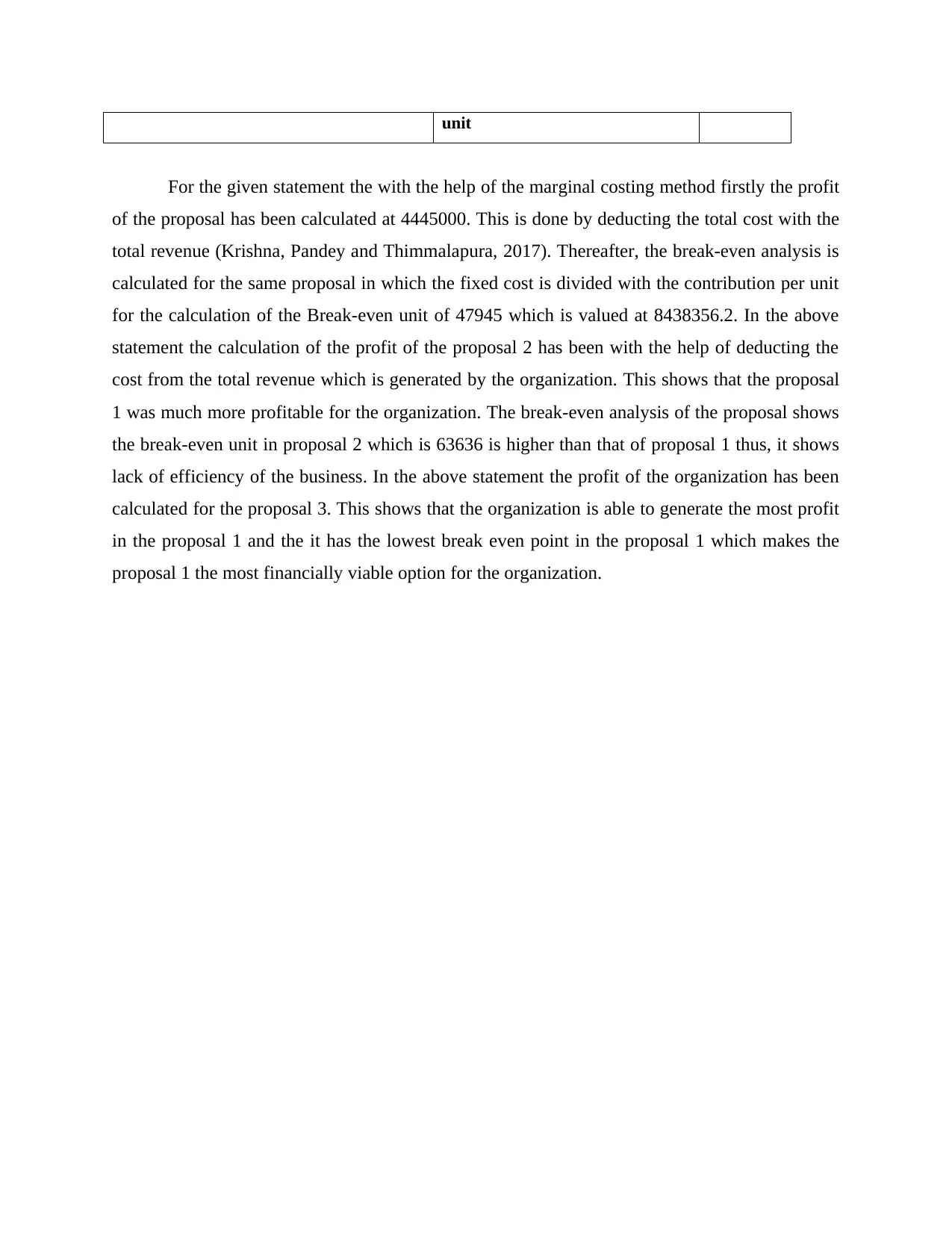
unit
For the given statement the with the help of the marginal costing method firstly the profit
of the proposal has been calculated at 4445000. This is done by deducting the total cost with the
total revenue (Krishna, Pandey and Thimmalapura, 2017). Thereafter, the break-even analysis is
calculated for the same proposal in which the fixed cost is divided with the contribution per unit
for the calculation of the Break-even unit of 47945 which is valued at 8438356.2. In the above
statement the calculation of the profit of the proposal 2 has been with the help of deducting the
cost from the total revenue which is generated by the organization. This shows that the proposal
1 was much more profitable for the organization. The break-even analysis of the proposal shows
the break-even unit in proposal 2 which is 63636 is higher than that of proposal 1 thus, it shows
lack of efficiency of the business. In the above statement the profit of the organization has been
calculated for the proposal 3. This shows that the organization is able to generate the most profit
in the proposal 1 and the it has the lowest break even point in the proposal 1 which makes the
proposal 1 the most financially viable option for the organization.
For the given statement the with the help of the marginal costing method firstly the profit
of the proposal has been calculated at 4445000. This is done by deducting the total cost with the
total revenue (Krishna, Pandey and Thimmalapura, 2017). Thereafter, the break-even analysis is
calculated for the same proposal in which the fixed cost is divided with the contribution per unit
for the calculation of the Break-even unit of 47945 which is valued at 8438356.2. In the above
statement the calculation of the profit of the proposal 2 has been with the help of deducting the
cost from the total revenue which is generated by the organization. This shows that the proposal
1 was much more profitable for the organization. The break-even analysis of the proposal shows
the break-even unit in proposal 2 which is 63636 is higher than that of proposal 1 thus, it shows
lack of efficiency of the business. In the above statement the profit of the organization has been
calculated for the proposal 3. This shows that the organization is able to generate the most profit
in the proposal 1 and the it has the lowest break even point in the proposal 1 which makes the
proposal 1 the most financially viable option for the organization.

REFERENCES
Books and Journals
Krishna, K.M., Pandey, N.K. and Thimmalapura, S., 2017, December. Break-even analysis and
economic viability of powertrain electrification—An analytical approach. In 2017 IEEE
Transportation Electrification Conference (ITEC-India) (pp. 1-6). IEEE.
Lessambo, F.I., 2018. Forecasting Financial Statements’ Analysis. In Financial Statements (pp.
251-258). Palgrave Macmillan, Cham.
Li, J., and et.al., 2018. Financial statements based bank risk aggregation. Review of Quantitative
Finance and Accounting, 50(3), pp.673-694.
Patil, D. and Mohanthy, J.N., 2017. Analysis of Financial Statements in the Sugar Industry.
Available at SSRN 2962855.
Books and Journals
Krishna, K.M., Pandey, N.K. and Thimmalapura, S., 2017, December. Break-even analysis and
economic viability of powertrain electrification—An analytical approach. In 2017 IEEE
Transportation Electrification Conference (ITEC-India) (pp. 1-6). IEEE.
Lessambo, F.I., 2018. Forecasting Financial Statements’ Analysis. In Financial Statements (pp.
251-258). Palgrave Macmillan, Cham.
Li, J., and et.al., 2018. Financial statements based bank risk aggregation. Review of Quantitative
Finance and Accounting, 50(3), pp.673-694.
Patil, D. and Mohanthy, J.N., 2017. Analysis of Financial Statements in the Sugar Industry.
Available at SSRN 2962855.
⊘ This is a preview!⊘
Do you want full access?
Subscribe today to unlock all pages.

Trusted by 1+ million students worldwide
1 out of 12
Related Documents
Your All-in-One AI-Powered Toolkit for Academic Success.
+13062052269
info@desklib.com
Available 24*7 on WhatsApp / Email
![[object Object]](/_next/static/media/star-bottom.7253800d.svg)
Unlock your academic potential
Copyright © 2020–2025 A2Z Services. All Rights Reserved. Developed and managed by ZUCOL.


